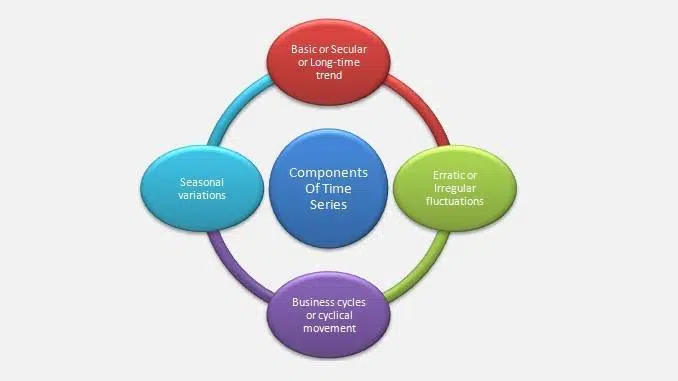
Components of Time Series in Statistics:
A time series is made up of the four components or elements listed below:
1. Basic or Secular or Long-time trend;
2. Seasonal variations;
3. Business cycles or cyclical movement; and
4. Erratic or Irregular fluctuations.
These elements or components provide the basis for explaining past behavior. They assist us in forecasting future behavior. (Predictions about the future using time series data are called forecasts.) The major tendency of each component or constituent is mostly determined by random circumstances. A brief description of these components and the causal factors associated with each component are given below.
1. Secular Trend:
The basic trend underlines the tendency to grow or decline over a period of years. It is the movement that the series would have taken, had there been no seasonal, cyclical, or unpredictable factors. It is the effect of factors that remain more or less constant over a long period of time or which change very slowly and gradually. Such factors include the gradual growth in population, tastes, and habits, as well as the effect on industrial productivity due to improved methods. An increase in the production of automobiles and a gradual decrease in the production of food grains are examples of increasing and decreasing secular trends.
All basic trends do not have the same nature. Sometimes a constant amount of growth will be the predominating tendency. This type of trend movement appears as a straight line when the trend values are plotted on graph paper. Sometimes the trend may be a constant percentage increase or decrease. When the trend values are plotted on a semilogarithmic chart, this type takes the shape of a straight line. Other types of trends encountered are “logistic”, “S-curves”, etc.
Correctly identifying and accurately measuring basic trends is one of the most important problems in time series analysis. The trend values are used as the basis for measuring the other three movements. Therefore, any inaccuracy in its measurement can spoil the whole work. Fortunately, the causal elements governing trend growth are relatively stable.
Trends usually do not change their nature quickly and without warning. Therefore, it is reasonable to assume that a representative trend, characterized by data for past periods, is currently prevailing, and can be predicted a year or so into the future.
2. Seasonal Variations:
The two principal factors liable for seasonal changes are the climate or weather and customs. Since the growth of all vegetation depends upon temperature and moisture, agricultural activity is confined largely to warm weather in the temperate zones and to the rainy or post-rainy season in the torrid zone (tropical countries or sub-tropical countries like India). Winter and dry seasons make farming a highly seasonal business. This high irregularity of month-to-month agricultural production determines largely all harvesting, marketing, canning, preserving, storing, financing, and pricing of farm products. Manufacturers, bankers, and merchants who deal with farmers find their business taking on the same seasonal pattern which characterizes the agriculture of their area.
The second cause of seasonal variation is custom, education, or tradition. Such traditional days as Diwali, Christmas, Holi, etc., product marked variations in business activity, travel, sales, gifts, finance, accident, and vacationing.
The successful operation of any business requires that its seasonal variations be known, measured, and exploited fully. Frequently, the purchase of seasonal items is made from six months to a year in advance. Departments with opposite seasonal changes are frequently combined in the same firm to avoid dull seasons and to keep sales or production up during the entire year.
Seasonal variations are measured as a percentage of the trend rather than in absolute quantities. The seasonal index for any month (week, quarter, etc.) may be defined as the ratio of the normally expected value (excluding the business cycle and erratic movements) to the corresponding trend value. When cyclical movement and erratic fluctuations are absent in a time series, such a series is called normal. Normal values thus are consisting of trend and seasonal components. Thus when normal values are divided by the corresponding trend values, we obtain the seasonal components of the time series.
3. Business Cycle:
Because of the persistent tendency for businesses to prosper, decline, stagnate recover; and prosper again, the third characteristic movement in economic time series is called the business cycle. The business cycle does not recur regularly like seasonal movement but moves in response to causes that develop intermittently out of complex combinations of economic and other considerations.
When the business of a country or a community is above or below normal, the excess deficiency is usually attributed to the business cycle. Its measurement becomes a process of contrasting occurrences with a normal estimate arrived at by combining the calculated trend and seasonal movements. The measurement of the variations from normal may be made in terms of actual quantities or it may be made in such terms as percentage deviations, which is generally a more satisfactory method as it places the measure of cyclical tendencies on a comparable base throughout the entire period under analysis.
4. Irregular Variations:
These movements are exceedingly difficult to dissociate quantitatively from the business cycle. Their causes are irregular and unpredictable happenings such as wars, droughts, floods, fires, pestilence, fads, and fashions which operate as spurs or deterrents upon the progress of the cycle. Examples of such movements are: high activity in the middle forties due to erratic effects of the 2nd world war, the depression of the thirties throughout the world, etc. The common denominator of every random factor is that it does not come about as a result of the ordinary operation of the business system and does not recur in any meaningful manner.
(Source – Various Books from college library)
Tags: what are the components of time series analysis, explain the components of time series, state the components of time series, four components of time series with examples, components of time series are mainly of
Copyrighted Material © 2019 - 2024 Prinsli.com - All rights reserved
All content on this website is copyrighted. It is prohibited to copy, publish or distribute the content and images of this website through any website, book, newspaper, software, videos, YouTube Channel or any other medium without written permission. You are not authorized to alter, obscure or remove any proprietary information, copyright or logo from this Website in any way. If any of these rules are violated, it will be strongly protested and legal action will be taken.




Be the first to comment